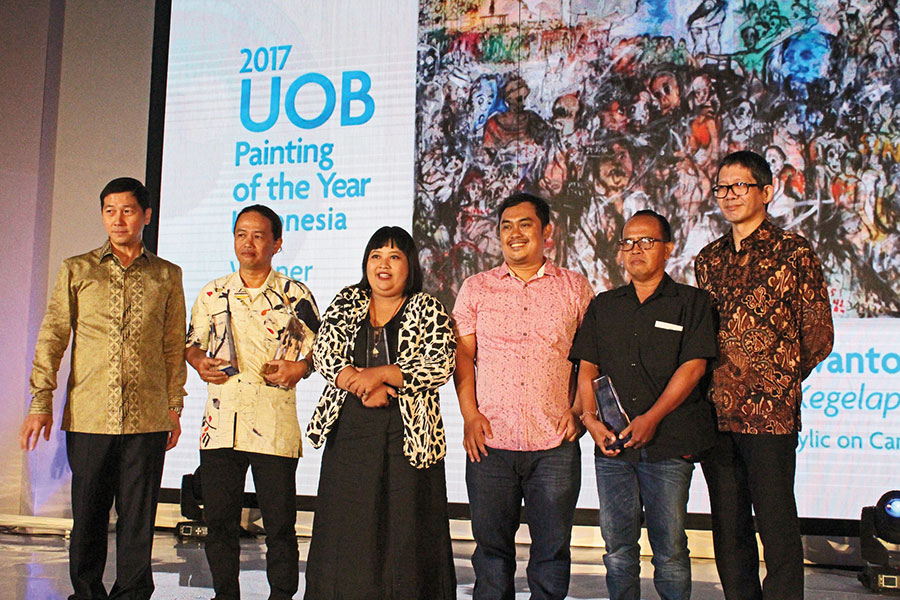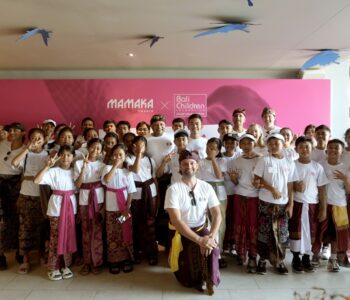The most significant display of contemporary art on the island during 2015 featured many of Bali’s finest artists exhibiting side-by-side with emerging talent. Violent Bali – Bali Art Intervention #1, opened at the Tony Raka Art Gallery, Ubud in November presenting eighty-five works raising issues such as identity, gender and cultural conflicts, and the New Order regime and the mass killing of 1965-66, among others.

One painting, however, stood alone for its pure economy of means. Distinguished by a balanced composition, minimal colouration and arresting imagery, the visual impact was immediate. Matching technical prowess with a controversial subject matter, the work’s essentials were complete. Torment by Citra Sasmita, one of only three exhibiting women, captivated the audience. The bold, yet disturbing narrative depicted a naked woman holding and kissing the snout of severed pigs head as blood drips from the pig, and the woman’s mouth. It ‘spoke’ of the psychological and physical abuse of women within the patriarchal Balinese society. Torment’s daring and aesthetic simplicity revealed Sasmita as an extraordinary young talent.

“You want to be an artist: you want to live poor?” was Sasmita’s fathers’ reaction upon learning that his daughter wanted to study fine art. Born in 1990 in Tabanan, Central Bali, as a child she had a passion for creative expression, and was destined to follow her heart. In conflict with her parents about her vocation, she studied literature and physics to appease them. While at university in Singaraja she joined a theatre group that inspired her love of art and literature. Sasmita began painting secretly, without her parent’s knowledge, eventually exhibiting in a small community event in 2012.
“A journalist from the Bali Post newspaper wrote about the exhibition, and my parents read the review. At first, they disagreed,” Sasmita said. “Yet upon their final wishes, they consented, and then gave me their approval for my art career. I have always reflected upon this,” and she adds. “Without their blessing, it seemed impossible to survive in the challenging and highly competitive world of art.”
After the exhibition, Sasmita was hired as an illustrator for short stories at the Bali Post. “Working at the Bali Post allowed me to investigate literature and symbolic forms that I began to adopt into my works. Art became the vehicle through which I could question my position as a Balinese woman.”
Promising to be the most important exhibition of the 2016 Bali art calendar, Merayakan Murni (Celebrating Murni) ran mid-year at Sudakara Art Space, Sanur. Contextualising the relevance, along with celebrating the legacy of iconic female Balinese artist I GAK Murniasih (1966-2006), the exhibition brought together the work of Murni along with 15 other local and international invitees. Sasmita’s installation Mea Vulva, Maxima Vulva, presented fifty small ceramic vaginas within a set of large out of balance scales, her reflection upon Balinese social class distinctions. Again she captured the audience’s imagination, while the critics paid due attention.

Even though Sasmita had entered many art competitions, success had always eluded her. “I became cynical. Unless you were from one of the art and cultural capitals of Java, like Yogyakarta, Bandung or Jakarta, it was difficult to win a national competition,” she explained. In October 2017, however, her composition Old Mountain and Imaginary Pillars was honoured with the prestigious Gold Award of the UOB Indonesian Painting of the Year 2017 competition, thrusting her into the national spotlight, while confirming her presence in the Indonesian contemporary art world.
“I have always doubted my chances in the UOB competition, last year however, was my first submission,” Sasmita said. “In my concept, I wrote whole-heartedly about the plight of women in the Indonesian art world, and about the struggle against gender bias and sexism, and that there are few opportunities for women to speak up through their art.”
Sasmita has chosen her ideology not only as a criticism, yet she endeavours to inspire empathy for those who are confronted with these social issues. “It means a lot to me to achieve recognition from people who have not been willing to listen to my artistic ‘voice’, and in some ways disrespect women in Indonesian art,” Sasmita said. “Winning this competition is a great thrill, I understand, however, that I must remain humble and focussed on my learning journey.”






